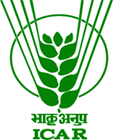 |
 |
 |
 |
 |
 |
During the third five year plan a crossbreeding program to Studying behaviour patterns of zebu crossbreds was initiated on 1 April 1968 at IVRI, Izatnagar and at Hisar centre of PAU, Ludhiana (presently CCSHAU, Hisar), with the base population of 820 Hariana cows which were crossed with Holstein (to bring in genes for fast growth and early maturity), Brown Swiss (to bring in the genes for hardiness) and Jersey (for small size, efficient feed conversion and high fat%). The project was aimed to determine simultaneously the relative performance of various inter crosses and choose an appropriate level of exotic inheritance (1/2 Vs 3/4) with a view to assess their relative suitability for evolving a dairy breed of cattle for arid zone of India. Later this project was merged with All India Coordinated Research Project (AICRP) on Cattle and four more centres were included, one each in Mysore, Maharashtra, Madhya Pradesh and Andhra Pradesh. The coordinating unit of the project was established at IVRI, Izatnagar. Further, an international crossbreeding project supported by the UNDPPL 480 and ICAR at Harringhatta also became part of the All India Coordinated Research Project on Cattle. As per the government policy, crossbreeding was advocated for non-descript cattle to produce half-bred with exotic donor, which emphasized on equal inheritance from both parents, one for contributing endurance and the other for higher productivity. Further these half-breds were suggested to breed among themselves, inter se, in subsequent generations to create large inter mating populations of half-bred. In order to maintain the genetic progress of this population, selection and use of genetically evaluated half bred sires were suggested. Even though the policy did not support the crossbreeding of indigenous cattle breeds of India, the impressive increase in milk production in the crossbreds had resulted in the expansion of crossbreeding programme throughout India, which even spread to breeding tracts of indigenous cattle. In the beginning the exotic breeds used in crossbreeding programme included Jersey, Brown Swiss, Red Dane and Holstein Friesian, but later the choice narrowed to Jersey and Holstein. Results from crossbreeding experiments have been conclusive that Holstein Friesian nicks well with all the Indian breeds, especially with Sahiwal irrespective of the environment. The experiments with other exotic breeds like Guernesy, Ayrshire, Shorthorn, Red Dane, Brown Swiss and Jersey did not produce encouraging results on overall performance basis. ICAR and military farms By 1980`s, due to the sustained crossbreeding, about 8 million crossbred cattle were born using various temperate exotic breeds. In order to stabilize this National milk herd, around 50% temperate inheritance; proven crossbred bulls of high genetic merit were required. To produce the required number of crossbred bulls it was necessary to fix the genetic value of the resultant new strain. In order to meet these twin objectives, a collaborative national project between ICAR and Military Farms was launched on 23 May 1985 utilizing the crossbred population with 3/8-7/8 Friesian inheritance at Military Farm Meerut (Bhat 1988) by Late General A.S. Vaidya, the then Chief of the Army Staff. The military farms besides being the largest single source of crossbred cattle in India they served as a source of data for the study of dairy animal improvement through the induction of superior exotic germplasm.The project Directorate on Cattle was established by the Indian Council of Agricultural Research (ICAR) as a nodal institution to monitor, co-ordinate and support all research and development projects for cattle improvement on 3 November 1987 at Military Farms School & Research Centre, Meerut, by upgrading the status of All-India Coordinated Research Project (AICRP) on Cattle. The directorate was conceived to take advantage of the achievements made in the AICRP and other crossbreeding experiments at organized farms especially at military farms and under field conditions for evolution of a national milch breed from a reasonably large crossbred base (Sahiwal × Holstein-Friesian). The directorate has been upgraded to Central Institute for Research on Cattle. Considering its sincere research and extension efforts and achievements made in cattle improvement, the PD on Cattle was upgraded as Central Institute for Research on Cattle during 2014. Thereafter, CIRC is acting as a nodal institution to monitor, coordinate and support all research and development projects for cattle improvement. The Institute is also providing good quality germplasm to stakeholders. The Institute also obtained ISO 9001:2015 certification and has well equipped semen freezing and molecular genetics Laboratories besides feed testing facilities in animal nutrition laboratory. Besides Institutional research programme on cattle genetics, nutrition, reproduction and management, sponsored research projects from DST, Government of India are also regularly taken by the Institute scientists.